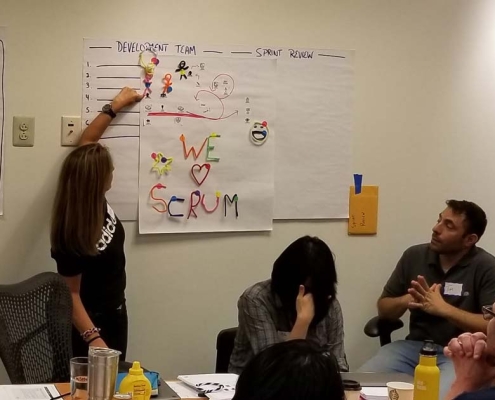What is Agile Project Management?

Scrum and Agile Project Management
Agile project management with Scrum is a popular framework used in software development and project management. This approach prioritizes delivering value to stakeholders through an iterative and incremental process, providing flexibility and adaptability to quickly respond to changes in requirements or priorities. In this article, we will explore the basics of Agile project management with Scrum, its importance in modern project management, and how it is applied in practice. We will also answer common questions and provide insights into how it can help organizations achieve their project goals.
Agile project management in simple terms
Agile project management is an iterative and incremental approach based on the Agile Manifesto’s principles of valuing individuals and interactions, working software, customer collaboration, and responding to change. It focuses on delivering value to stakeholders through regular delivery of working software or solutions. The benefits of using Agile project management include increased flexibility, faster time to market, improved stakeholder satisfaction, team collaboration, and communication, leading to better outcomes and higher productivity.
The Scrum Framework
Scrum is a popular Agile project management approach that helps teams work together to develop complex products based on the principles of transparency, inspection, and adaptation. Scrum was developed in the 1990s by Jeff Sutherland and Ken Schwaber and is based on five events and one activity:
- The Sprint: a fixed length event of one month or less, typically 1-4 weeks in duration.
- Sprint Planning: the team meets to plan the upcoming Sprint, identifying the work to be done and estimating the effort required.
- Daily Scrum: a short, daily planning meeting where the team checks in with each other, discusses progress, roadblocks, and plans for the day.
- Sprint Review: the team demonstrates the work completed during the Sprint and gathers feedback from stakeholders.
- Sprint Retrospective: a meeting where the team reflects on the Sprint and identifies ways to improve processes, communication, and collaboration.
- Product Backlog Refinement: an ongoing process where the team reviews and updates the Product Backlog, containing the list of features and requirements for the project.
Agile project management with Scrum
Agile project management with Scrum is a powerful framework allowing teams to deliver high-quality products and solutions. Scrum is applied in Agile project management by breaking the project into smaller iterations or Sprints, typically lasting one to four weeks, focused on delivering a small piece of functionality or feature. The team collaborates to plan the Sprint, identifies the work to be done, and the Sprint’s goal. During the Sprint, the team meets daily to review progress, identify any roadblocks, and plan the next day’s work. At the end of the Sprint, the team reviews the work completed and gathers feedback from stakeholders.
Scrum roles/accountabilities are crucial to the success of Agile project management with Scrum. The Scrum Master facilitates the process and ensures the team adheres to Scrum principles and practices. With organizations working in both Waterfall and Scrum, the Project Managers may serve as one of the three roles on the Scrum Team, managing the project and ensuring it meets the stakeholders’ needs. Scrum project planning and Sprint planning are critical components of Agile project management with Scrum.
Comparison between Agile and Scrum project management
Agile project management is an overarching approach focusing on delivering value to stakeholders through an iterative and incremental process, while Scrum is a specific Agile process control framework designed to help teams work together to develop complex products. Agile is a philosophy, a mindset, and a way of being….Agile is an attitude! We ultimately should be asking ourselves how do we execute our work with Agility in mind. Scrum is just one of the ways that we can execute with business agility in mind.
Scrum Certification and Training: Who, Why, and How
Scrum is a framework that is widely used in software development and project management, but it can be applied to any industry or domain that involves complex product development. In this section, we will discuss Scrum certification and training, including who should study Scrum, the benefits of Scrum certification, and how to become a Scrum Master with no experience.
Who should study Scrum?
Anyone who is involved in product development, project management, or software development can benefit from studying Scrum. It is focused on collaboration, communication, and adaptability, which are applicable to many industries and domains. Non-IT persons can learn Scrum as well.
Benefits of Scrum Certification
Scrum certification offers several benefits, including increased job opportunities, improved project management skills, and higher earning potential. Scrum certification demonstrates that you have a deep understanding of Scrum methodology and can effectively apply it in practice.
How to Become a Scrum Master with No Experience
To become a Scrum Master with no experience, you can start by studying Scrum and obtaining a Scrum certification with the Scrum Alliance, the largest Scrum certifying body and community in the world. The cost and time required to obtain the CSM can vary depending on the certification program and the level of experience of the individual. Some Scrum certification programs can be completed in a few days, while others may take several months. The cost of Scrum certification also varies, but it typically ranges from a few hundred to a few thousand dollars.
Read one of our latest articles on how to become a Certified Scrum Master.
Scrum in Program Management

Marshmallow Challenge
Scrum is not only used in project management, but it can also be applied in program management. In this section, we will explore the application of Scrum in program management and the benefits and challenges it presents.
Using Scrum in program management can help to ensure that the program delivers value to stakeholders through an iterative and incremental process. One of the main benefits of using Scrum in program management is increased transparency and communication. Scrum provides a structured framework for teams to work together, which can help to ensure that everyone is on the same page and that progress is visible to all stakeholders. However, using Scrum in program management also presents some challenges. Coordinating multiple teams and projects can be complex and time-consuming. It can also be challenging to balance the needs of individual projects with the overall goals and objectives of the program.
Conclusion
Agile project management with Scrum is a powerful methodology that can help organizations to deliver high-quality products that meet the needs of stakeholders. While there are some challenges associated with using Scrum in project management, the benefits it offers make it a valuable option for organizations. Scrum provides a structured framework for collaboration and communication, which can lead to better outcomes and higher satisfaction for all involved parties. By focusing on collaboration, communication, and adaptability, Scrum provides a powerful approach to project management that can help organizations to succeed in a rapidly changing world.


